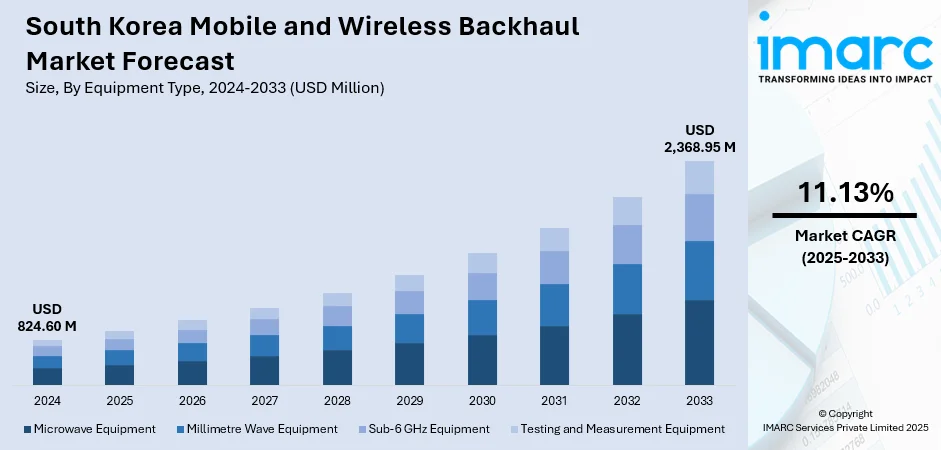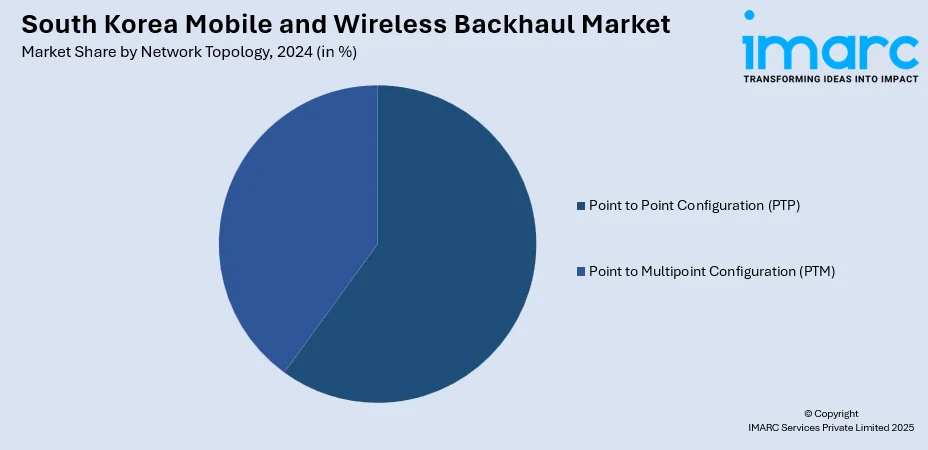
South Korea Mobile and Wireless Backhaul Market Size, Share, Trends and Forecast by Equipment Type, Network Topology, Services, and Region, 2025-2033
South Korea Mobile and Wireless Backhaul Market Overview:
The South Korea mobile and wireless backhaul market size reached USD 824.60 Million in 2024. Looking forward, the market is projected to reach USD 2,368.95 Million by 2033, exhibiting a growth rate (CAGR) of 11.13% during 2025-2033. Rising data traffic, 5G rollout, and demand for low-latency connectivity are driving the market. Government investments in smart infrastructure and expanding urban coverage further support the increasing South Korea mobile and wireless backhaul market share.
|
Report Attribute
|
Key Statistics
|
|---|---|
|
Base Year
|
2024 |
|
Forecast Years
|
2025-2033
|
|
Historical Years
|
2019-2024
|
| Market Size in 2024 | USD 824.60 Million |
| Market Forecast in 2033 | USD 2,368.95 Million |
| Market Growth Rate 2025-2033 | 11.13% |
South Korea Mobile and Wireless Backhaul Market Trends:
Integration of 5G Infrastructure
A prominent trend in the South Korea mobile and wireless backhaul market is the accelerated deployment of 5G infrastructure. With nationwide 5G expansion a key government objective, telecom providers are upgrading existing backhaul systems to accommodate higher data rates and ultra-low latency requirements. For instance, in February 2024, Stage X, a consortium led by Kakao affiliate Stage Five, secured South Korea’s 28 GHz spectrum to become the country’s fourth mobile operator. Paying over USD 322 Million, Stage X outbid rivals to enter the competitive 5G market. The company plans to offer 28 GHz 5G services using devices from Samsung, Apple, and Google. The shift from legacy microwave links to high-capacity fiber and millimeter wave technologies is enabling more efficient transport networks suited for 5G traffic. These changes are particularly evident in dense urban areas like Seoul and Busan, where data demands from users and enterprises are among the highest. This trend reflects the broader trajectory of South Korea mobile and wireless backhaul market growth, aligning with global technological advancements and policy support aimed at reinforcing digital competitiveness and connectivity standards.

To get more information on this market, Request Sample
Rising Adoption of Millimeter Wave and Sub-6 GHz Technologies
The South Korea mobile and wireless backhaul market is experiencing increased adoption of millimeter wave and sub-6 GHz technologies, driven by their ability to offer higher throughput and more reliable performance in varied terrains. These frequency bands are especially useful in bridging coverage gaps in densely populated regions and geographically constrained locations. As 5G densification progresses, operators are leveraging these bands for short-range but high-capacity links that complement fiber deployments. Additionally, the flexibility and cost-efficiency of these wireless solutions make them suitable for rapid network rollouts, particularly in rural and semi-urban zones. This technological shift is playing a critical role in sustaining South Korea mobile and wireless backhaul market growth across diverse topographies and deployment scenarios. For instance, in February 2025, South Korean researchers at ETRI have developed aerial mobile network technology that enables high-speed wireless communication during disasters. Using drones and UAM vehicles equipped with 5G small cells and backhaul terminals, the system achieved 1.3 Gbps over 2.5 km and 300 Mbps over 10 km, supporting emergency communications when ground infrastructure fails.
South Korea Mobile and Wireless Backhaul Market Segmentation:
IMARC Group provides an analysis of the key trends in each segment of the market, along with forecasts at the country/regional level for 2025-2033. Our report has categorized the market based on equipment type, network topology, and services.
Equipment Type Insights:
- Microwave Equipment
- Millimetre Wave Equipment
- Sub-6 GHz Equipment
- Testing and Measurement Equipment
The report has provided a detailed breakup and analysis of the market based on the equipment type. This includes microwave equipment, millimetre wave equipment, sub-6 GHz equipment, and testing and measurement equipment.
Network Topology Insights:

- Point to Point Configuration (PTP)
- Point to Multipoint Configuration (PTM)
A detailed breakup and analysis of the market based on the network topology have also been provided in the report. This includes point to point configuration (PTP) and point to multipoint configuration (PTM).
Services Insights:
- Network Services
- System Integration Services
- Professional Services
The report has provided a detailed breakup and analysis of the market based on the services. This includes network services, system integration services, and professional services.
Regional Insights:
- Seoul Capital Area
- Yeongnam (Southeastern Region)
- Honam (Southwestern Region)
- Hoseo (Central Region)
- Others
The report has also provided a comprehensive analysis of all the major regional markets, which include Seoul Capital Area, Yeongnam (Southeastern Region), Honam (Southwestern Region), Hoseo (Central Region), and others.
Competitive Landscape:
The market research report has also provided a comprehensive analysis of the competitive landscape. Competitive analysis such as market structure, key player positioning, top winning strategies, competitive dashboard, and company evaluation quadrant has been covered in the report. Also, detailed profiles of all major companies have been provided.
South Korea Mobile and Wireless Backhaul Market Report Coverage:
| Report Features | Details |
|---|---|
| Base Year of the Analysis | 2024 |
| Historical Period | 2019-2024 |
| Forecast Period | 2025-2033 |
| Units | Million USD |
| Scope of the Report |
Exploration of Historical Trends and Market Outlook, Industry Catalysts and Challenges, Segment-Wise Historical and Future Market Assessment:
|
| Equipment Types Covered | Microwave Equipment, Millimetre Wave Equipment, Sub-6 GHz Equipment, Testing and Measurement Equipment |
| Network Topologies Covered | Point to Point Configuration (PTP), Point to Multipoint Configuration (PTM) |
| Services Covered | Network Services, System Integration Services, Professional Services |
| Regions Covered | Seoul Capital Area, Yeongnam (Southeastern Region), Honam (Southwestern Region), Hoseo (Central Region), Others |
| Customization Scope | 10% Free Customization |
| Post-Sale Analyst Support | 10-12 Weeks |
| Delivery Format | PDF and Excel through Email (We can also provide the editable version of the report in PPT/Word format on special request) |
Key Questions Answered in This Report:
- How has the South Korea mobile and wireless backhaul market performed so far and how will it perform in the coming years?
- What is the breakup of the South Korea mobile and wireless backhaul market on the basis of equipment type?
- What is the breakup of the South Korea mobile and wireless backhaul market on the basis of network topology?
- What is the breakup of the South Korea mobile and wireless backhaul market on the basis of services?
- What is the breakup of the South Korea mobile and wireless backhaul market on the basis of region?
- What are the various stages in the value chain of the South Korea mobile and wireless backhaul market?
- What are the key driving factors and challenges in the South Korea mobile and wireless backhaul market?
- What is the structure of the South Korea mobile and wireless backhaul market and who are the key players?
- What is the degree of competition in the South Korea mobile and wireless backhaul market?
Key Benefits for Stakeholders:
- IMARC’s industry report offers a comprehensive quantitative analysis of various Korea market segments, historical and current market trends, market forecasts, and dynamics of the South Korea mobile and wireless backhaul market from 2019-2033.
- The research report provides the latest information on the market drivers, challenges, and opportunities in the South Korea mobile and wireless backhaul market.
- Porter's five forces analysis assist stakeholders in assessing the impact of new entrants, competitive rivalry, supplier power, buyer power, and the threat of substitution. It helps stakeholders to analyze the level of competition within the South Korea mobile and wireless backhaul industry and its attractiveness.
- Competitive landscape allows stakeholders to understand their competitive environment and provides an insight into the current positions of key players in the market.
Need more help?
- Speak to our experienced analysts for insights on the current market scenarios.
- Include additional segments and countries to customize the report as per your requirement.
- Gain an unparalleled competitive advantage in your domain by understanding how to utilize the report and positively impacting your operations and revenue.
- For further assistance, please connect with our analysts.
 Request Customization
Request Customization
 Speak to an Analyst
Speak to an Analyst
 Request Brochure
Request Brochure
 Inquire Before Buying
Inquire Before Buying




.webp)




.webp)












